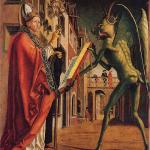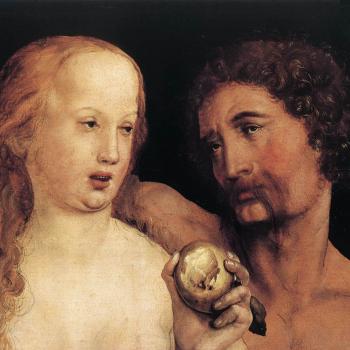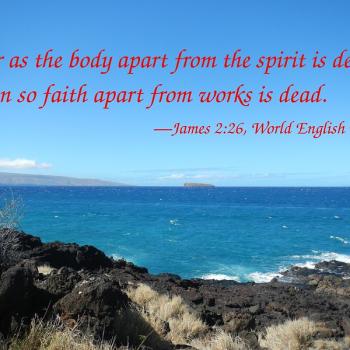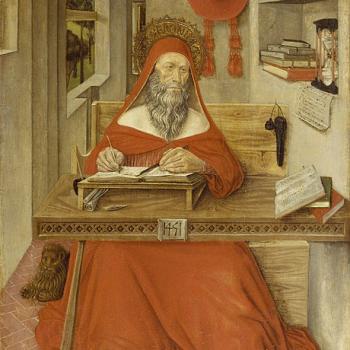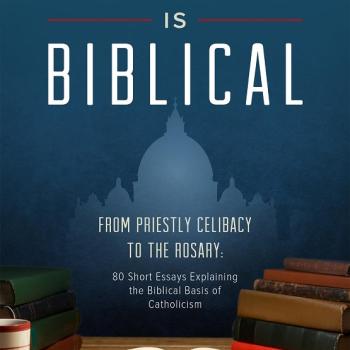with Dr. Robert Fastiggi

Jay Dyer is a former Calvinist, former Catholic, currently Orthodox Christian, who now makes (among many other treatments on various topics) vigorous theological arguments against the Catholic Church. He’s a very zealous and sharp guy and gives it the old college try with all the gusto he can. I do surely appreciate those qualities.
I ran across his article, “Dr. Taylor Marshall Refuted — Inherited guilt and Contradictions” (10-29-19), which is essentially about the Catholic historical and speculative belief (but not dogma, as I will explain) of limbo. I’d like to respectfully disagree with some arguments and assumptions in it. His words will be in blue.
Is it true that inherited guilt was never taught and that it only meant the effects of Adam’s sin (something closer to Orthodox theology)? On the contrary, what this issue shows is the massive evolution and innovation of dogma on the part of the Roman Church on this question. In fact, not only have recent discussions on this topic shed light on this mistaken recast, it also shows two places Roman Catholic dogmatic theology has specifically contradicted on the matter, as well will see [sic]. First, we must recall that in the Latin West after St. Augustine it was the norm that unbaptized infants are all de facto damned: Augustine was very clear on his view of that matter, while the East knew no such clear rigor in the matter and commended these infants to God’s mercy.
This is his first misunderstanding of Catholic authority and the magisterium of the Church: its very Rule of Faith. Individual Church fathers or even Doctors of the Church, no matter how great (and Augustine was great) are nevertheless not magisterial. Whether he dominated thought in the late first millennium on the question of limbo (a “norm”?) and the eternal destiny of unbaptized infants or not, matters not a hill of beans, if the Church didn’t officially state a doctrine and bind her members to it. All it shows is that “a bunch of Catholic theologians tended to believe x about question y, which was an area of not-yet-determined or dogmatized speculative theology.”
As an analogy to first millennium Eastern Christianity, which morphed into Eastern Orthodoxy after 1054, the consensus at one point for quite a while was that iconoclasm (destruction of religious images and regarding them as blasphemous idols) was quite the “norm” and consensus. Folks felt so strongly about it that the East formally withdrew its communion from the See of Rome due to this issue in the time periods of 726-787 and 815-843. That’s about 89 years out of 117.
Yet we all know that Eastern Orthodoxy is very fond of images and icons and is renowned for the sublime beauty of its religious images. It (or I should say its Eastern Catholic predecessors or forerunners) was still working out its view in the 8th and 9th centuries, while Rome had the correct view (as always, because of God’s special protection of the popes: successors of St. Peter) all along.
There can be theological speculation of any number of topics, but the magisterium is something else again. The Catholic Church did not, for example, follow Augustine’s semi-Calvinistic view of double predestination. Augustine was simply wrong on the question, and the Church in due course (basically in line with Orthodoxy and Arminian / Wesleyan / non-Calvinist Protestantism) authoritatively decided that he was. Even St. Thomas Aquinas was wrong about the Immaculate Conception of Mary, and the Church in her wisdom decided to follow the (in retrospect) more spiritually advanced line of thought of Blessed Duns Scotus instead. St. Jerome was wrong about the deuterocanonical books, etc.
The Church fathers can be looked to as guides, in the sense that consensus views held by them (called “unanimous consent” but literally meaning general agreement) are generally regarded at length as truths or true theology and doctrines, and as such, the Church has usually adopted them. But they simply aren’t authoritative in and of themselves, even as a group, just as bishops are not today, and not even in the context of an ecumenical council, unless the pope approves what they propose.
Regardless, in the West by the late Middle Ages the doctrine became clear as the Vatican’s own recent declaration on infants [approved by Pope Benedict XVI in January 2007] (which Marshall completely ignored) as unbaptized infants were considered part of the mass damnata:
He cites four sections of this document, starting with section 5, which begins: “The fate of unbaptised infants first became the subject of sustained theological reflection in the West during the anti-Pelagian controversies of the early 5th century.” Exactly. But (again) that ain’t the magisterium: just as the anti-icon iconoclasts in the 8th and 9th centuries didn’t represent the considered opinion of the Eastern Church (Eastern Catholicism today) or Eastern Orthodoxy, as both developed, lo these past 1177 years.
In its second paragraph, the same document makes it quite clear that limbo was never Catholic dogma (though always a permissible opinion, as it still is today):
This theory, elaborated by theologians beginning in the Middle Ages, never entered into the dogmatic definitions of the Magisterium, even if that same Magisterium did at times mention the theory in its ordinary teaching up until the Second Vatican Council. It remains therefore a possible theological hypothesis. However, in the Catechism of the Catholic Church (1992), the theory of limbo is not mentioned. Rather, the Catechism teaches that infants who die without baptism are entrusted by the Church to the mercy of God, as is shown in the specific funeral rite for such children. The principle that God desires the salvation of all people gives rise to the hope that there is a path to salvation for infants who die without baptism (cf. CCC, 1261), and therefore also to the theological desire to find a coherent and logical connection between the diverse affirmations of the Catholic faith: the universal salvific will of God; the unicity of the mediation of Christ; the necessity of baptism for salvation; the universal action of grace in relation to the sacraments; the link between original sin and the deprivation of the beatific vision; the creation of man “in Christ”. [my bolding]
Later, the document (which I’m absolutely delighted that Jay brought up!) clarifies again, along the same lines:
33. The history of theology and of magisterial teaching show in particular a development concerning the manner of understanding the universal saving will of God. The theological tradition of the past (antiquity, the Middle Ages, the beginning of modern times), in particular the Augustinian tradition, often presents what by comparison with modern theological developments would seem to be a “restrictive” conception of the universality of God’s saving will. . . . At the level of the magisterium, this larger perception was progressively affirmed. . . .
34. In the Church’s tradition, the affirmation that children who died unbaptised are deprived of the beatific vision has for a long time been “common doctrine”. This common doctrine followed upon a certain way of reconciling the received principles of revelation, but it did not possess the certitude of a statement of faith, or the same certitude as other affirmations whose rejection would entail the denial of a divinely revealed dogma or of a teaching proclaimed by a definitive act of the magisterium. The study of the history of the Church’s reflection on this subject shows that it is necessary to make distinctions. In this summary we distinguish first, statements of faith and what pertains to the faith; second, common doctrine; and third, theological opinion. . . .
37. c) In the documents of the magisterium in the Middle Ages, the mention of “different punishments” for those who die in actual mortal sin or with original sin only (“As for the souls of those who die in mortal sin or with original sin only, they go down immediately to hell, to be punished, however, with different punishments”) must be interpreted according to the common teaching of the time. Historically, these affirmations have certainly been applied to unbaptised infants, with the conclusion that these infants suffer punishment for original sin. It must be observed however that, in a general way, the focus of these Church pronouncements was not on the lack of salvation for unbaptised infants, but on the immediacy of the particular judgment after death and the assignment of souls to heaven or hell. These magisterial statements do not oblige us to think that these infants necessarily die with original sin, so that there would be no way of salvation for them. . . .
38. d) The Bull “Auctorem fidei” of Pope Pius VI is not a dogmatic definition of the existence of Limbo: the papal Bull confines itself to rejecting the Jansenist charge that the “Limbo” taught by scholastic theologians is identical with the “eternal life” promised to unbaptised infants by the ancient Pelagians. Pius VI did not condemn the Jansenists because they denied Limbo, but because they held that the defenders of Limbo were guilty of the heresy of Pelagius. By maintaining the freedom of the Catholic Schools to propose different solutions to the problem of the fate of unbaptised infants, the Holy See defended the common teaching as an acceptable and legitimate option, without endorsing it. [my bolding]
This should make Jay and other Orthodox Christians happy, in the sense that our views, as they have developed — especially in more recent years –, are very close to their own. Unity is a good thing, because it means that more truth is believed by more people (with less annoying contradiction) and we Christians are better witnesses to a dying world. But Jay would rather spend his time making hay of supposed remaining differences, based on his own misunderstandings or limited knowledge of how the Catholic magisterium has always functioned.
This was the normative view in the Latin West for centuries, as well as in papally-affirmed medieval Roman Dogma, as we will see.
This is untrue, as just shown. It was a popular view among theologians in a certain period, but this far stricter, almost Calvinist view was already opposed as early as St. Thomas Aquinas and the other scholastics, and increasingly as time went on. It was not dogmatized, as the very same document that Jay produced makes clear. And so there simply is no issue here. Jay is mistaken, pure and simple. If something is allowed to be speculated upon, and expressly not decided or made dogma by the Church (much as with the different conceptions of predestination: Thomist vs. Molinist), then there is no contradiction if one “pole” of the allowed diversity of speculation in due course becomes more prominent than the other.
From the outset, however, we can see that Marshall’s simplistic portrayal doesn’t even take into account these well-known issues, but presents the Roman view as if it was a coherent dogmatic presentation.
I don’t know what Taylor argued, and frankly, don’t much care, in light of his recent descent into wacko conspiratorialism and anti-papalism (which has wrecked any apologetic or theological credibility he had), but I know that this wasn’t a dogmatic dispute at any time, because it has never been made into a dogma. It was simply theological speculation about deep, difficult ideas arising from the “intersection” of baptism, original sin, and salvation and its rewards and joys in the afterlife. Therefore, such disagreements were fully allowed and were nothing even out of the ordinary, let alone supposedly “troublesome” for the Catholic position. Jay basically refuted his own argument by bringing up the 2007 Vatican document, which came in very handy indeed for me and was (literally) just what I was looking for. Thanks, Jay!
Rather, the Roman dogma evolved from the post-Augustinian period to affirm the well-known idea of the limbo of infants, which would eventually achieve dogmatic status in Rome.
This supposed imaginary “dogma” didn’t “evolve” at all. Evolution of dogma was condemned by Pope St. Pius X. Newmanian development of doctrine, on the other hand, is perfectly orthodox (accepted enthusiastically by the same pope), and occurs in Orthodoxy as well as Catholicism. What happened was that one theological speculation was dominant, but was eventually overcome by another, which prevails now. both developed over time, but the non-Augustinian view that eventually prevailed, developed more.
It took a while, but that’s how much of theology is. The same thing happens in Orthodoxy, which has ‘late” developments, even including its cherished notion of Divine Energies, as I dealt with at length in my book chapter, Development of Doctrine in Orthodoxy & Catholicism: Is There an Essential Difference? (co-authored by Byzantine Catholic Fr. Daniel Dozier), in the 2015 edition of our book, Orthodoxy and Catholicism: A Comparison.
Next, however, we want to illustrate Denzinger shows a clear contradiction in Roman Dogma in admitting on the one hand circumcision remitted original sin (Denzinger 410) and later at Florence it clearly did not, as Florence claims the rites of the Old Testament did not confer the grace they signified. This is yet another absurd contradiction in Roman Catholic dogma:
“410 (For) they assert that baptism is conferred uselessly on children. . . . We respond that baptism has taken the place of circumcision. . . . Therefore as “the soul of the circumcised did not perish from the people” [Gen. 17:4], so “he who has been reborn from water and the Holy Spirit will obtain entrance to the kingdom of heaven” [ John 3:5]. . . .Although original sin was remitted by the mystery of circumcision, and the danger of damnation was avoided, nevertheless there was no arriving at the kingdom of heaven, which up to the death of Christ was barred to all. But through the sacrament of baptism the guilt of one made red by the blood of Christ is remitted, and to the kingdom of heaven one also arrives, whose gate the blood of Christ has mercifully opened for His faithful.” [his bolding]
This is not a mere opinion, this is papally-approved dogma in Denzinger that easily falls under the classification of universal ordinary magisterium (supposedly protected by the charism of infallibility). . . .
In direct contradiction to Denzinger 410, the Council of Florence later states the opposite concerning circumcision:
“Decree for the Armenians *
[From the Bull “Exultate Deo,” Nov. 22, 1439]
695 In the fifth place we have reduced under this very brief formula the truth of the sacraments of the Church for the sake of an easier instruction of the Armenians, the present as well as the future. There are seven sacraments of the new Law: namely, baptism, confirmation, Eucharist, penance, extreme unction, orders, and matrimony, which differ a great deal from the sacraments of the Old Law. For those of the Old Law did not effect grace, but only pronounced that it should be given through the passion of Christ; these sacraments of ours contain grace, and confer it upon those who receive them worthily.” [his bolding]
Of course, being the Olympic level experts in mental gymnastics they are, I suppose it’s possible for Roman Catholics to say the way to reconcile the two would be to have forgiveness in the Old Testament without grace, but at that point the only appropriate reaction is to laugh at the cope.
This is a very fine point, for which I had no immediate refutation (as I have never encountered it, nor thought about it before). Credit to Jay for coming up with a good “stumper”-like inquiry. I would have to do more research in order to resolve the alleged contradiction.
But rather than go that time-consuming route, I asked my friend, systematic theologian and editor and translator of the latest edition of Denzinger, Dr. Robert Fastiggi (arguably, one of the most qualified Catholic scholars in the entire world to answer such a question) about it. I was quite confident that he could plausibly explain this proposed conundrum, as indeed he now has. Here is his reply:
Dyer is wrong to insinuate there is a contradiction between Innocent III’s statement in his 1201 Letter to Archbishop Humbert of Arles (Denz.-R, 410; Denz.-H 780) and the Council of Florence’s Bull of Union with the Armenians of 1439 (DR, 695 and DH, 1310). The sacraments of the Old Law “prefigured the grace to be given through the Passion of Christ,” but they did not cause grace as the Catholic sacraments do. Innocent III rightly notes that original sin was remitted by the mystery of circumcision. This remission was due to the prefigurement of baptism in circumcision. This was Christian grace by anticipation (to use the language of Cardinal Charles Journet), but circumcision was not like baptism that causes and communicates grace.
The Catholic sacraments are instituted by Christ and draw their power of sanctification from his Paschal Mystery. Jay Dyer seems to miss the key point in Innocent III’s 1201 letter, viz., that the just of the Old Covenant could not enter the kingdom of heaven until the sacrifice of Christ was offered. The Old Testament saints avoided damnation, but the gates of heaven remained closed to them. The sacraments of the New Law enable us to go to heaven because they contain and communicate the saving grace of Christ (and not merely prefigure it). I don’t see any contradiction between Innocent III and the Decree for the Armenians.
Source
Denz.-H or DH = Denzinger-Hünermann, 40th ed. (Herder, 2005). [Denz.-R is an earlier version with different numbering]
Dr. Fastiggi also shared with me another article he wrote, entitled, “Original Sin and the Closing of the Gates of Heaven”. It ties directly into our subject matter, so I will share it in its entirety:
*****
The Catechetical Tradition
According to the 1566 Catechism of the Council of Trent (also known as The Roman Catechism), before Christ’s death and resurrection, “heaven was closed against every child of Adam.” Where, then, did the souls of the just go? According to this Catechism (Part I, article 5) “the souls of the just, on their departure from this life, were either borne to the bosom of Abraham; or, as is still the case with those who have something to be washed away or satisfied for, were purified in the fire of purgatory.”
The Catechism of the Catholic Church, editio typica (1997) repeats this teaching in no. 637 where it is stated that in his descent into hell, Christ “opened heaven’s gates for the just who had gone before him.”
What does it mean to say, “the gates of heaven were closed to the just” before Christ’s saving death? It seems to mean that the holy ones before the time of Christ were in a state of waiting for the full experience of blessedness, i.e. the beatific vision. The grace which enabled them to become just or holy was “Christian grace by anticipation” to use Journet’s terminology (see The Meaning of Grace [1996] p. 94). The just souls before Christ were “saved,” but, according to the teaching of the Church’s Magisterium, the gates of heaven were still closed until the historical offering of Christ’s sacrifice on the Cross.
At the Synod of Arles in A.D. 473, the priest, Lucidus, was forced to make a submission according to a formula composed by Bishop Faustus of Riez, which was sent to the thirty synodal bishops of Gaul. In this formula, Lucidus was obliged to say:
I also declare that through the order and course of the centuries some have been saved by the law of grace, others by the law of Moses, others by the law of nature, which God has written into the hearts of all [cf. Rom 2:15), in the hope of Christ’s coming; nevertheless, from the beginning of the world, none has been set free from the original bondage except by the intercession of the sacred blood [Denz.-H * 341].
The passion and death of Christ were offered as the acceptable sacrifice to God to free us from the bondage brought about by Adam’s sin. The Council of Trent, in its Decree on Original Sin [1546] anathematizes those who believe that “the sin of Adam” can be taken away by any means other than the merits of our Lord Jesus Christ “who reconciled us to God by his blood” (Denz.-H, 1513; ND, 510). Prior to the sacrifice of Christ on the Cross, the holy ones were in a state of waiting for the saving work of Christ. This state of waiting is referred to variously as the “bosom of Abraham” or the “limbo of the Fathers.” The Apostles’ Creed professes belief in Christ’s descent into hell or the lower regions (ad inferna or ad inferos). What is the purpose of this descent into hell? In the Creed of Fourth Synod of Toledo (A.D. 633) we are told that Christ “descended into hell to free the holy ones being held there” (descendit ad inferos, ut sanctos, qui ibidem tenebantur, erueret; Denz.-H, 485). These souls were holy (sanctos) but they still needed to be freed from the bondage of Adam’s sin by the sacrifice of Christ on the Cross.
In his 1201 letter to Archbishop Humbert of Arles, Pope Innocent III teaches that kingdom of heaven was closed before the death of Christ. Thus, we read:
Even though original sin was remitted by the mystery of circumcision and the danger of damnation avoided, nevertheless, one could not enter into the kingdom of heaven, which remained closed to all until the death of Christ [Denz.-H, 780; ND, 1409).
This same teaching is affirmed at the ecumenical Council of Florence in its 1442 Bull of Union with the Copts and the Ethiopians, Cantate Domino (also called the “Decree for the Jacobites”). We are told that:
[The Holy Roman Church] firmly believes, professes and teaches that never was anyone conceived by a man and a woman liberated from the devil’s dominion except by faith in our Lord Jesus Christ, the mediator between God and man [cf. 1 Tim 2:5], who without sin was conceived, born, and died. He alone by his death overthrew the enemy of the human race, canceling our sins, and unlocked the entrance to the heavenly kingdom, which the first man by his sin, together with all his posterity, had lost. All the holy sacrifices, sacraments, and ceremonies of the Old Testament had prefigured that he would come at some time [Denz.-H, 1347].
Questions: Were not Enoch (Gen 5:21-24; Heb 11:5) and Elijah (2 Kings 2:11) taken up to heaven before the coming of Christ? Were not Elijah and Moses in heaven in glory when they appeared with Christ in the Transfiguration?
Response: The cases of Enoch and Elijah show that God is capable of preserving certain individuals from bodily death. These cases, though, do not prove that these Old Testament saints experienced the beatific vision prior to the coming of Christ. They could have gone to the metaphorical “bosom of Abraham” in a state of joyous anticipation for the beatific vision. As for the Transfiguration, it can be understood as a vision of eschatological glory given to the apostles. It does not prove that Moses and Elijah were already in heavenly glory experiencing the beatific vision.
Question: If Mary was preserved from original sin in view of the foreseen merits of Christ, why could not the merits of Christ be applied to the holy ones who lived before the time of Christ to free them from original sin and bring them to the beatific vision?
Response: In terms of divine omnipotence, God could certainly have done this. Whether He actually did so is only speculation. We need to judge the matter in terms of the traditional understanding of the descent into hell and magisterial teaching, which states that the “gates of heaven” were closed before the coming of Christ. In the case of Mary, the Church teaches that she was preserved from all stain of original sin by “the singular grace and privilege of Almighty God” (Pius IX, Denz.-H, 2803; ND, 709). To say that the Old Testament saints had been released from the stain of original sin prior to the Mary’s Immaculate Conception takes away from the singular privilege of her special preservation from original sin as the New Eve. Mary, in fact, represents the fulfillment of the “proto-Gospel” of Gen 3:15, which speaks of the enmity between the Devil and “the woman.” The reason for this enmity is that Mary, as the New Eve, was never under bondage to sin, original or personal, from the first moment of her conception.
Question: But is it not true the when people die they enter into the “eternal state,” and so they might go straight to the time of eschatological fulfillment, i.e. the full glory of heaven?
Response: While it is true that time will be experienced differently after death, the speculation that, when people die, they go right into the “end times” has been rejected by Catholic teaching (See Appendix I to the Second Edition of Eschatology by Joseph Ratzinger [CUA Press, 2007], pp. 252-253). This view implies a denial of the interim state between personal death and bodily resurrection, which is rejected indirectly by Benedict XII in 1336 (Denz.-H, 1000; ND, 2305), where he teaches that the beatific vision is experienced prior to the resurrection of the body. It is also rejected by the Congregation for the Doctrine of the Faith in 1979 (Denz.-H, 4653; ND, 2317). Moreover, we need to consider the simple fact that we see the bodily remains of the saints on earth while we pray for their heavenly intercessions.
Sources
Denz.-H = Denzinger-Hünermann, 40th ed. (Herder, 2005).
ND = Neuner & Dupuis, The Christian Faith in the Doctrinal Documents of the Catholic Church (New York: Alba House, 1982).
*****
***
Related Reading
Has Limbo Been Relegated to Limbo? (It Never Was Definitive Teaching) (12-28-07)
Unbaptized Infants (Fr. William G. Most, EWTN)
Catholic Encyclopedia (1910): “Limbo”
No, the Limbo of Infants is Not Defined Catholic Dogma (Scott Eric Alt, National Catholic Register, 4-5-16)
***
Photo credit: [Pikist / public domain]
***


